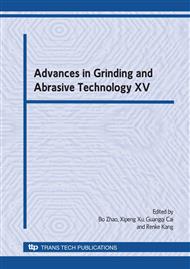p.509
p.514
p.519
p.524
p.529
p.535
p.540
p.546
p.553
Study on Grinding Performance of Soft Abrasive Wheel for Silicon Wafer
Abstract:
With the development of IC manufacturing technology, the machining precision and surface quality of silicon wafer are proposed much higher, but now the planarization techniques of silicon wafer using free abrasive and bonded abrasive have the disadvantage of poor profile accuracy, environmental pollution, deep damage layer, etc. A soft abrasive wheel combining chemical and medical effect was developed in this paper, it could get super smooth, low damage wafer surface by utilizing mechanical friction of abrasives and chemical reaction among abrasives, additives, silicon. A comparison experiment between #3000 soft abrasive wheel and #3000 diamond abrasive wheel was given to study on the grinding performance of soft abrasive wheel. The results showed that: wafer surface roughness ground by soft abrasive wheel was sub-nanometer and its sub-surface damage was only 0.01µm amorphous layer, which were much better than silicon wafer ground by diamond abrasive wheel, but material removal rate and grinding ratio of soft abrasive wheel were lower than diamond wheel. The wafer surface ground by soft abrasive wheel included Ce4+, Ce3+, Si4+, Ca2+ and Si, which indicated that the chemical reaction really occurred during grinding process.
Info:
Periodical:
Pages:
529-534
Citation:
Online since:
September 2009
Authors:
Keywords:
Price:
Сopyright:
© 2009 Trans Tech Publications Ltd. All Rights Reserved
Share:
Citation:


